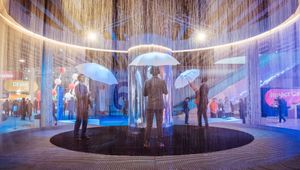
The Future of Sports Marketing: Hyper Personalisation and Inclusivity in Sports

Image credit: Ian Higbee via Unsplash
A large proportion of sport fans encounter challenges at games due to overwhelming sounds, crowds, noise and lights. Should brands and partners step up to the plate, crafting compassionate experiences for all fans? Sports marketing can break these barriers and build a more inclusive fanbase and more accessible environments.
Hyper-personalisation is no longer a luxury but a necessity in all forms of marketing. This is especially true in a fragmented and democratised sports landscape. Parking the current debate around the hike in football season ticket prices, in its purest sense, fans from all walks of life are able to follow and engage with whatever sports they choose. The plethora of dedicated social and digital channels, linear platforms, official and fan driven websites - before we get into the fantasy sports and betting worlds - create an ecosystem of entertainment whereby fandom is fuelled 24/7.
But any sports fan will agree that this is only a substitute for watching your team or favourite sports-person perform in-person.
As rights holders and brands alike seek to create fan engagement activities which not only complement their existing fan base but also reach new and often younger audiences, the role of effective experiential marketing needs to resist the urge to morph into ‘something for everyone’. Live events and experiences also face the worthy challenges presented by the might of targeted social spend and SEO which feed fans curated content 24/7. In short, the best experiential marketing is not an exercise in creating vanilla campaigns and activations but one with its own role to play in delivering hyper-personalised experiences.
The only way is hyper-personalisation
When it comes to experiential marketing how do we truly know who we’re engaging with and how best to communicate our messaging? Where can we avoid the blurring of demographics thrown up through mass engagement and multi-layered fandom to ensure we can also attract those who may be missing out due to niche needs?
Now more than ever, the road to hyper-personalisation is the road to results.
With so much going on - even without the advent of AI generated messaging - our preferences are determined by a complex matrix of inputs, with a number of ways to achieve a brand’s goal through a myriad of intertwined factors. Optimising data-driven insights to include this segment will allow brands to deliver targeted messages that resonate with specific audiences.
To quote Gwynne Shotwell, president and COO of SpaceX, “We have to leverage the gifts that we have to make other people’s lives better. That is how we should be using our power.”
Enhancing the Fan Experience
Wherever the activity takes place, owned, paid or earned, we must be cognisant of the ever increasingly wide range of fans, and potentially non-fans there in a supporting capacity. Our activities by their very nature need to enhance the action rather than detract from it. In doing so, the industry can be a crucial ingredient in each member's enjoyment leading to the conversation being heard in schools, offices, pubs and, of course, on the world’s most influential platform, social media.
One of the most celebrated factors of the human race is its diversity and complexity. As such, the way we all communicate and receive information differs depending on time, place, mood, age, demographic, etc. We therefore need to be cognisant of how information is conveyed as much as what we are communicating.
Being welcomed into this conversation could be more about the ‘how’ than the ‘what’ and relies on a communication strategy that conveys key information in the knowledge that the engagement and demographic will vary.
Creating Inclusive Environmental Engagement Opportunities
To ensure we’re listening to the needs of our ever expanding fan bases, should we, for example consider, fusing social interactions using engaging influencer-led communications with custom-driven literature or websites? This has the opportunity to create engagement opportunities for those previously considered to be on the margins of interactions resulting in those members feeling included and proud to call that sport - and the brands facilitating their experiences - a community in which they can actively associate.
There’s a laundry list of potential options for opening up the inclusions in experiential operations, depending on the ambition, appetite and, of course, budget. However, unless we know precisely who’s attending each event, we should broaden our horizons.
Brands must take a more inclusive angle to ensure they’re truly creating welcoming activations, like braille displays or an area offering information in text-to-voice or large format copy.
The Success Story: Tottenham Hotspur
A great example of a sports team making the effort to understand this often overlooked fan segment is the English football club, Tottenham Hotspur. They’ve worked with this audience to gain a deeper insight into what would aid fans with sensory requirements when attending a game and have created ‘social stories’ to familiarise attendees with their environments.
Consideration has even been given to bathrooms where the sound of a hand dryer can be potentially triggering. In addition to this, they provide ‘quiet spaces’ during firework or light displays. The club potentially has an advantage as one of the newer stadiums in the UK however consideration and consultation have led to, by all accounts, a “safe gameday” atmosphere for everyone.
Simon Blewett, disability access officer at Tottenham Hotspur, said, “We are proud of our Stadium because of the vast range of experiences we are able to offer for our supporters, which includes fans with sensory impairment conditions. Our Sensory Suite gives supporters the flexibility to watch a match in an environment that suits them, which allows us to accommodate fans from all walks of life.”
This proactive nature from Spurs has generated extra fandom; recent attendance from a neurodiverse father and son duo attending the NFL at the Spurs stadium had such a positive experience that they’ve both pledged their allegiance to the Tottenham Faithful.
“There can be a perception of football fans all fitting into one demographic, but this is far from the case, and the response to our Sensory Suite proves that beyond doubt. We receive incredible feedback from our fans who make use of the area, and they appreciate that they are being considered in this way. It is important to realise that you are providing not only a sporting event, but also an entertainment spectacle.” said Simon.
We can’t be everything for everyone but brands should consider how to reach all audiences - including those with disabilities - to ensure they’re given the opportunity to be as involved as possible.
Sport should be at the very top of the democratic enjoyment pyramid; there is something for everyone out there by creating the right environment for all fans and rights holders. In doing so, we help create the opportunity for a lifetime of great sporting memories by simply listening to the audiences.
Writes Edd Hood, senior director Sports Activation, George P. Johnson UK














